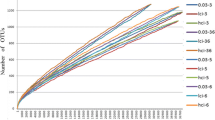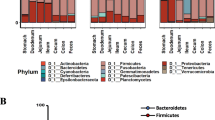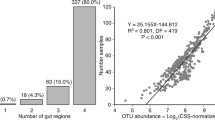Abstract
Despite having a typical carnivorous digestive tract, the giant panda has a diet consisting exclusively of bamboo, a low-efficiency food source. Given this paradox, we sought to investigate if the giant panda digestive tract is inhabited by organisms indicative of high cellulose diet or their gastrointestinal tract anatomy. The diversity and dynamics of the predominant bacteria in the fecal flora of two adult (male and female) and one young (male) giant panda reared in two different zoos over a 2-year period was studied using 16S rDNA-based approaches. The temperature gradient gel electrophoresis (TGGE) profiles of the 16S rDNA V3 region of the three individuals were highly similar. The structure of their fecal flora remained relatively stable over the 2-year period. Both the most predominant band in TGGE patterns shared by the three pandas and the biggest operational taxonomic unit (OTU) in the clone library were phylogenetically related to Escherichia coli. Gram-negative, facultative bacteria constituted almost 60% of the whole community in the clone library. All the OTUs were related to previously described phylotypes known to reside in the intestine or rumen. The results of our study indicate that the predominant bacterial populations in the intestine of the three pandas were markedly different from that of herbivores. The unbalanced intestinal community structure may play a role in the inefficient digestion of bamboo by the giant pandas.




Similar content being viewed by others
References
Amann, RI, Ludwig, WH, Schleifer, K (1995) Phylogenetic identification and in situ detection of individual microbial cells without cultivation. Microbiol Rev 59: 143–169
Arends, JP, Zanen, HC (1988) Meningitis caused by Streptococcus suis in humans. Rev Infect Dis 10: 131–137
Brosius, J, Palmer, ML, Kennedy, PJ, Noller, HF (1978) Complete nucleotide sequence of a 16S ribosomal RNA gene from Escherichia coli. Proc Natl Acad Sci USA 75: 4801–4805
Burrell, PC, O’Sullivan, C, Song, H, Clarke, WP, Blackall, LL (2004) Identification, detection, and spatial resolution of Clostridium populations responsible for cellulose degradation in a methanogenic landfill leachate bioreactor. Appl Environ Microbiol 70: 2414–2419
Chen, HW, Li, GH, Zhang, AJ, Feng, WH, Zhang, ZH (1997) The study on the oestrus and ovulation induced by exogenous gonadotropin in giant panda (Ailuropoda melanoleuca). In: Proceedings of the International Symposium on the Protection of the Giant Panda, Chengdu, Sichuan Publishing House of Science and Technology, China, pp 94–98 (in Chinese, with English abstract).
Davis, DD (1964) The giant panda: a morphological study of evolutionary mechanisms. Fieldiana Zool Mem 3: 1–337
Devriese, LA, van de Kerckhove, A, KilpperBalz, R, Schleifer, KH (1987) Characterization and identification of Enterococcus species isolated from the intestines of animals. Int J Syst Bacteriol 37: 257–259
Dice, LR (1945) Measures of the amount of ecological association between species. J Ecol 26: 297–302
Dierenfeld, ES, Hintz, HF, Robertson, JB, Van Soest, PJ, Oftedal, OT (1982) Utilization of bamboo by the giant panda. J Nutr 112: 636–641
Eckburg, PB, Bik, EM, Bernstein, CN, Purdom, E, Dethlefsen, L, Sargent, M, Gill, SR, Nelson, KE, Relman, DA (2005) Diversity of the human intestinal microbial flora. Science 308: 1635–1638
Feng, WH, Zhang, AJ (1996) Studies on the development of ovarian follicles and oocytes of giant pandas. Acta Theriol Sinica 3: 161–165 (in Chinese, with English abstract)
Feng, WH, Li, GH (2000) The Saving of Giant Panda. Sichuan Publishing House of Science and Technology, Sichuan, China (in Chinese)
Franks, AH, Harmsen, HJ, Raangs, GC, Jansen, GJ, Schut, F, Welling, GW (1998) Variations of bacterial populations in human feces measured by fluorescent in situ hybridization with group-specific 16S rRNA-targeted oligonucleotide probes. Appl Environ Microbiol 64: 3336–3345
Gibson, GR, Roberfroid, MB (1995) Dietary modulation of the human colonic microbiota: introducing the concept of prebiotics. J Nutr 125: 1401–1412
Gill, SR, Pop, M, Deboy, RT, Eckburg, PB, Turnbaugh, PJ, Samuel, BS, Gordon, JI, Relman, DA, Fraser-Liggett, CM, Nelson, KE (2006) Metagenomic analysis of the human distal gut microbiome. Science 312: 1355–1359
Good, IJ (1953) The population frequencies of species and the estimation of population parameters. Biometrica 40: 237–264
Hammond, AC, Allison, MJ, Williams, MJ, Prine, GM, Bates, DB (1989) Prevention of leucaena toxicosis of cattle in Florida by ruminal inoculation with 3-hydroxy-4-(1H)-pyridone-degrading bacteria. Agricultural Research Service, Subtropical Agricultural Research Station, Brooksville, FL 34605. Am J Vet Res 50(12): 2176–2180
Hirayama, K, Kawamura, S, Mitsuoka, T, Tashiro, K (1989) The faecal flora of the giant panda (Ailuropoda melanoleuca). J Appl Bacteriol 67: 411–415
Jones, RJ, Megarrity, RG (1986) Successful transfer of DHP-degrading bacteria from Hawaiian goats to Australian ruminants to overcome the toxicity of Leucaena. Aust Vet J 63: 259–262
Knarreborg, AR, Engberg, M, Jensen, SK, Jensen, BB (2002) Quantitative determination of bile salt hydrolase activity in bacteria isolated from the small intestine of chickens. Appl Environ Microbiol 68: 6425–6428
Kocherginskaya, SA, Aminov, RI, White, BA (2001) Analysis of the rumen bacterial diversity under two different diet conditions using denaturing gradient gel electrophoresis, random sequencing, and statistical ecology approaches. Anaerobe 7: 119–134
Larsen, N, Olsen, GJ, Maidak, BL, McCaughey, MJ, Overbeek, R, Macke, TJ, Marsh, TL, Woese, CR (1993) The ribosomal database project. Nucleic Acids Res 21: 3021–3023
Leser, TD, Amenuvor, JZ, Jensen, TK, Lindecrona, RH, Boye, M, Moller, K (2002) Culture-independent analysis of gut bacteria: the pig gastrointestinal tract microbiota revisited. Appl Environ Microbiol 68: 673–690
Li, M, Gong, J, Cottrill, M, Yu, H, de Lange, C, Burton, J, Topp, E (2003) Evaluation of QIAamp DNA Stool Mini Kit for ecological studies of gut microbiota. J Microbiol Methods 54: 13–20
Liu, JW (1984) On the gross anatomy of the stomach of the giant panda. Acta Theriol Sinica 30: 311–316
Mackie, RI, White, BA (1990) Recent advances in rumen microbial ecology and metabolism: potential impact on nutrient output. J Dairy Sci 73: 2971–2995
Maidak, BL, Cole, JR, Parker, CT, Jr., Garrity, GM. Larsen, N, Li, B, Lilburn, TG, McCaughey, MJ, Olsen, GJ, Overbeek, R, Pramanik, S, Schmidt, TM, Tiedje, JM, Woese, CR (1999) A new version of the RDP (Ribosomal Database Project). Nucleic Acids Res 27: 171–173
Muyzer, G, de Waal, EC, Uitterlinden, AG (1993) Profiling of complex microbial populations by denaturing gradient gel electrophoresis analysis of polymerase chain reaction-amplified genes coding for 16S rRNA. Appl Environ Microbiol 59: 695–700
Pryde, SE, Richardson, AJ, Stewart, CS, Flint, HJ (1999) Molecular analysis of the microbial diversity present in the colonic wall, colonic lumen, and cecal lumen of a pig. Appl Environ Microbiol 65: 5372–5377
Shen, J, Zhang, B, Wei, G, Pang, X, Wei, H, Li, M, Zhang, Y, Jia, W, Zhao, L (2006) Molecular profiling of the Clostridium leptum subgroup in human fecal microflora by PCR-denaturing gradient gel electrophoresis and clone library analysis. Appl Environ Microbiol 72: 5232–5238
Simpson, JM, McCracken, VJ, White, BA, Gaskins, HR, Mackie, RI (1999) Application of denaturant gradient gel electrophoresis for the analysis of the porcine gastrointestinal microbiota. J Microbiol Methods 36: 167–179
Sneath, PHA, Sokal, RR (1973) The estimation of taxonomic resemblance. In: Kennedy D, Park RB (eds) Numerical Taxonomy. The Principles and Practice of Numerical Classification. Freeman, San Francisco, pp 129–32
Suau, A, Bonnet, R, Sutren, M, Godon, JJ, Gibson, GR, Collins, MD, Dore, J (1999) Direct analysis of genes encoding 16S rRNA from complex communities reveals many novel molecular species within the human gut. Appl Environ Microbiol 65: 4799–4807
Tan, Z (2004) The study on the normal intestinal microflora of the giant panda returned to wild and the giant panda in captivity. Journal of Sichuan University (Natural Science edition) 41: 1276–1279
Thompson, JR, Marcelino, LA, Polz, MF (2002) Heteroduplexes in mixed-template amplifications: formation, consequence and elimination by ‘reconditioning PCR’. Nucleic Acids Res 30: 2083–2088
Trottier, S, Higgins, R, Brochu, G, Gottschalk, M (1991) A case of human endocarditis due to Streptococcus suis in North America. Rev Infect Dis 13: 1251–1252
Varel, VH, Yen, JT, Kreikemeier, KK (1995) Addition of cellulolytic clostridia to the bovine rumen and pig intestinal tract. Appl Environ Microbiol 61: 1116–1119
Wang, RF, Cao, WW, Cerniglia, CE (1996) PCR detection and quantitation of predominant anaerobic bacteria in human and animal fecal samples. Appl Environ Microbiol 62: 1242–1247
Whitford, MC, Forster, RJ, Beard, CE, Gong, J, Teather, RM (1998) Phylogenetic analysis of rumen bacteria by comparative sequence analysis of cloned 16S rRNA genes. Anaerobe 4: 153–163
Wilson, KH, Blitchington, RB (1996) Human colonic biota studied by ribosomal DNA sequence analysis. Appl Environ Microbiol 62: 2273–2278
Wilson, KH, Ikeda, JS, Blitchington, RB (1997) Phylogenetic placement of community members of human colonic biota. Clin Infect Dis 25(Suppl 2): S114–S116
Zhang, ZH, He, GX, Wang, XL, Zhong, SL (1988) The study on the giant panda’s intestinal flora. Acta Theriol Sinica 15: 170–175
Zoetendal, EG, Akkermans, AD, De Vos, WM (1998) Temperature gradient gel electrophoresis analysis of 16S rRNA from human fecal samples reveals stable and host-specific communities of active bacteria. Appl Environ Microbiol 64: 3854–3859
Acknowledgements
We thank Huiyu Jing and Qiang Sun in Shanghai Safari for their assistance in collecting the fecal samples. This study was supported by a grant from the National Natural Science Foundation of China (30370031).
Author information
Authors and Affiliations
Corresponding author
Rights and permissions
About this article
Cite this article
Wei, G., Lu, H., Zhou, Z. et al. The Microbial Community in the Feces of the Giant Panda (Ailuropoda melanoleuca) as Determined by PCR-TGGE Profiling and Clone Library Analysis. Microb Ecol 54, 194–202 (2007). https://doi.org/10.1007/s00248-007-9225-2
Received:
Revised:
Accepted:
Published:
Issue Date:
DOI: https://doi.org/10.1007/s00248-007-9225-2




